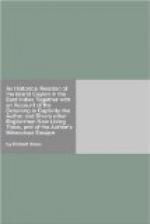[Lands descend.] To hint some of them, their Lands are hereditary, and do descend from Parents to their Children. But the eldest son by Priviledg of Birth-right does not possess and enjoy all the Land, but if the Father please he can divide it among his Children. Yet in case the eldest son does enjoy the Land, then without dispute he is to maintain his Mother and her Children until they come to years or ability to provide for themselves.
[In case Corn receives dammage by a Neighbours Cattle.] They have a custom in the Land Ouvah, which is a great breeder of Cattle, and hath but very little Wood, so that they have not where with to make hedges; It is that when they sow their Lands, they drive their Cattle thence, and watch them all day that they break not into the Corn; and at night they tie their Cattle to secure them from straying into the Corn-Lands: otherwise if one Neighbours Cattle eats another neighbours Corn, he must pay the dammage.
Those that are lazy and loath to Plow, or that are Poor and want Corn to sow, the Custom is, to let out their ground to others to Till at Ande, that is at halves; but fees and accustomable dues taken, out by the Husbandman that tills it, the Owner of the Land receives not much above a third part.
[The loss of leting out land to Till.] For the Husband hath divers considerable payments besides his half share of the Corn. As namely, first he hath Cotoumaun, that is, so much Corn as they scratch off from the whole heap of trodden Corn by drawing a bundle of Thorns over it. Secondly, Waracool, that is a consideration for the expences they are at in Tilling and Sowing; for which there is a Rate according to the bigness of the field. Thirdly, Warrapoll, that is the Corn they leave at the bottom of the heap after they have done fanning. Which is the Womans fee for their pains in weeding the Corn, and in pulling it it up where it is too thick, and planting it where it is thin, &c. Fourthly, Bolerud which is the Chaff and sweepings of the Pit. This sometimes comes to a considerable value according to the quantity of Corn that is trodden. Fifthly, Peldorah, which is a piece of Corn they leave standing before the watch house, which is set up in their Corn grounds to watch their Corn from the wild beasts. And this left standing is the fee for watching. There is yet another due Ockyaul which belongs to their Gods, and is an offering sometimes carried away by the Priest; and sometimes they bestow it upon the beggar, and sometimes they will take it and hang it up in their houses, and at convenient time sacrifice it themselves. It is one of their measures, which is about half a Peck.
[The great consideration for Corn borrowed.] And in the mean time until this Corn is ripe, the Owner is fain to go a borrowing Corn to sustain himself and Family. Which he pays consideration for; which is, when his own Corn is ripe, a bushel and an half for a bushel that is, at the rate of Fifty per Cent. Which manner of lending Corn is a means that doth maintain many strangers and others. For they who have got a small stock of Corn by that Profit may competently live upon it. Which was the means that Almighty God prepared for my relief and maintenance.




